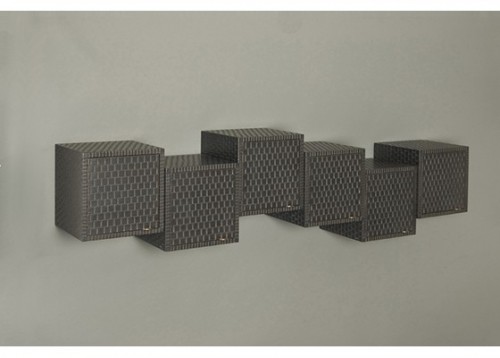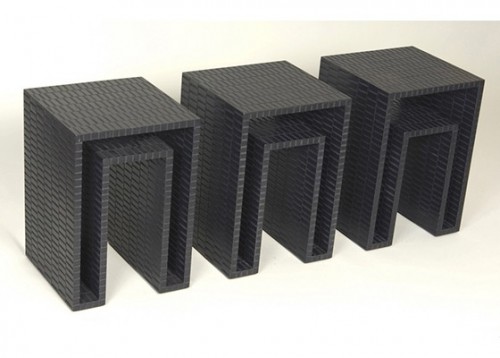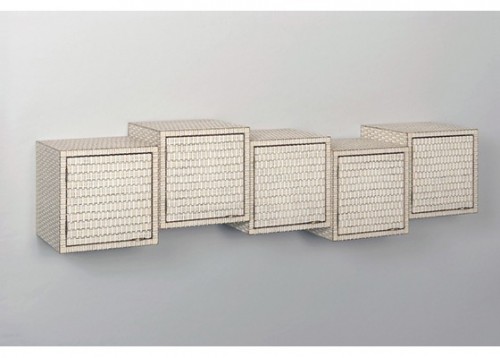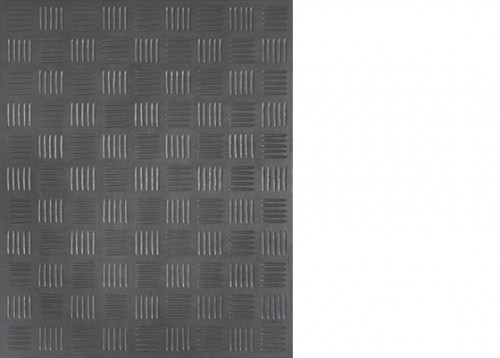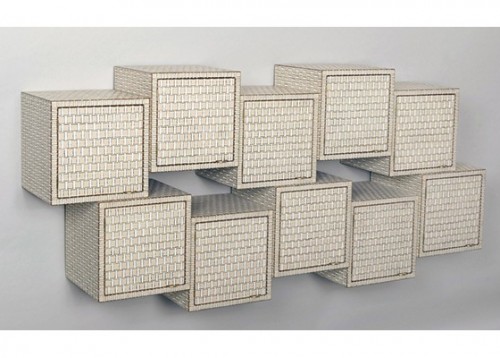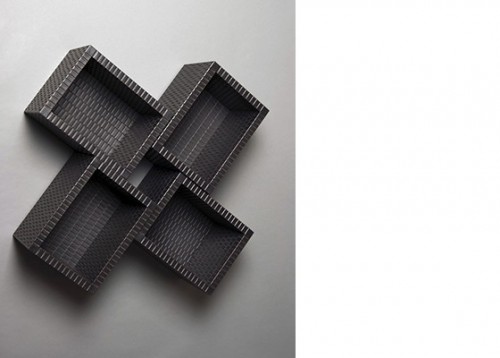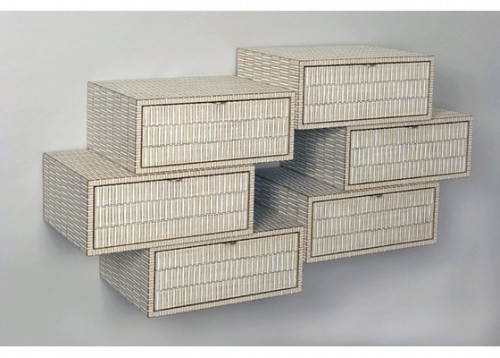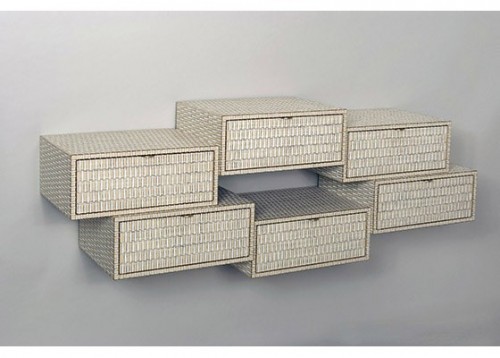John Eric Byers Studio Furniture, Gallery Naga
Squares and Rectangles: Functional Carved Paintings
By: Mark Favermann - May 04, 2008
Squares and RectanglesMarch 28 to April 26
Gallery Naga
67 Newbury Street
Boston, MA 02216
http://www.gallerynaga.com
When done well, artist created studio furniture is craft, visual art and design combined at their highest form. John Eric Byers is studio furniture maker who is at the top of his form and is perhaps one of the most acclaimed and prolific of his generation. Besides scores of private commissions, Byers has had twenty-two one-man shows since 1991.
His exhibition at Gallery Naga was show Number 22 which recently closed. Squares and Rectangles presented his newest works of wall cabinets and mall tables. Each of the furniture pieces were reduced to essential geometries that were totally covered in complex carved patterns. These pieces were literally carved paintings.
These pieces demonstrated a mastery of craftsmanship and furniture design while adding a dimension of contemporary painterliness. Carved Painting White #3 (2007) and Carved Painting Black #3 (2007) underscore this point. Each is a simple rectangle methodically and meticulously worked, layer by layer, literally carved inch by inch. Underpainting followed by sanding, coats and coats of milk paint, sanding after each coat, touch ups and top coating followed by three coats of lacquer comprised the surface enhancement process.
Similarly, all the pieces in the show are done this way. This is a skill few can do with subtlety and refinement. Intriguingly, Byers' works exhibit both a calmness and intensity that is visually demonstrated through his precise, minimalist forms. The surfaces of each piece though varying in color reveal an astounding number of gouged marks on every object face.
Upon close inspection, the surfaces show that these marks describe even smaller geometries. Each is similar but different. Therefore, there is a painter's hand here even in the hands of someone creating masterful functional sculpture. Squares and rectangles cover every surface of each wall-hung cabinet and each small table like intricate geometric south Pacific island tattoos. Yet, there is also a sense of Asian philosophy to the objects as well. There is a craft and technical dexterity here that suggests Eastern rather than Western sensibility. Perhaps, this is the calmness and intensity.
The artist has stated that there are between 8,000 to 12,000 squares and rectangles on each of his pieces. Here more is more from a starting place that starts with less is more. This is particularly physically impressive in light of his two shoulder surgeries in 2005 and 2006, each needing six months of rehab. The time off was softened and perhaps made more therapeutic by two prestigious 2005 awards. One was from the New York Foundation of the Arts, and the other from the Louis Comfort Tiffany Foundation. The prestigeous Tiffany Award had in the past honored only studio furniture makers much older than mid-forties John Eric Byers.
Some of his most elegant pieces are his smallest. Twin white and black Open Form end table sets were constructed so that there was an inner structure that gave a sense of inner gravity to each small piece of furniture. There was interesting varying symmetry and asymmetry to the hanging cabinets that allowed for a contrasting and complex visual balance. Ten Square Cabinet White and Ten Square Cabinet Black (2007) and Six Rectangles of Drawers #1 visually reverse and counterpoint normal geometric or Euclidean centerlines. The ancient technique of using milk paint to cover surfaces gave a sense of connectedness to each piece and to the entire studio furniture exhibit as a whole.
He bounced back with two solo shows in 2006, in New York and Philadelphia. The work for these shows moved his work toward the present look, a refinement to the simplest, "purest" shapes possible. This was achieved almost entirely in his buttermilk-and-snow palette with occasional pieces in black. According to Naga Gallery Director Arthur Dion, a 2007 carved black painting by Byers was presented in a group show at Gallery NAGA and drew great enthusiasm. This encouraged Byers to make the alluring black furniture shown in this exhibit.
A fully illustrated elegant catalog with an essay by NAGA director Arthur Dion accompanied the Byers' show, Dion is of course the "Godfather of Studio Furniture" championing, recognizing and fostering the movement for over two and half decades.
Even though there is a sense of uniformity to the exhibit pieces, there is a subtle and even cerebral difference between seemingly similar pieces. This demonstrates that John Eric Byers' work is masterful, elegant and object as art as well as art as object in every sense—visual, tactile, visceral and even a bit Zen-like, spiritual.
Upon close inspection, the surfaces show that these marks describe even smaller geometries. Each is similar but different. Therefore, there is a painter's hand here even in the hands of someone creating masterful functional sculpture. Squares and rectangles cover every surface of each wall-hung cabinet and each small table like intricate geometric south Pacific island tattoos. Yet, there is also a sense of Asian philosophy to the objects as well. There is a craft and technical dexterity here that suggests Eastern rather than Western sensibility. Perhaps, this is the calmness and intensity.
The artist has stated that there are between 8,000 to 12,000 squares and rectangles on each of his pieces. Here more is more from a starting place that starts with less is more. This is particularly physically impressive in light of his two shoulder surgeries in 2005 and 2006, each needing six months of rehab. The time off was softened and perhaps made more therapeutic by two prestigious 2005 awards. One was from the New York Foundation of the Arts, and the other from the Louis Comfort Tiffany Foundation. The prestigeous Tiffany Award had in the past honored only studio furniture makers much older than mid-forties John Eric Byers.
Some of his most elegant pieces are his smallest. Twin white and black Open Form end table sets were constructed so that there was an inner structure that gave a sense of inner gravity to each small piece of furniture. There was interesting varying symmetry and asymmetry to the hanging cabinets that allowed for a contrasting and complex visual balance. Ten Square Cabinet White and Ten Square Cabinet Black (2007) and Six Rectangles of Drawers #1 visually reverse and counterpoint normal geometric or Euclidean centerlines. The ancient technique of using milk paint to cover surfaces gave a sense of connectedness to each piece and to the entire studio furniture exhibit as a whole.
He bounced back with two solo shows in 2006, in New York and Philadelphia. The work for these shows moved his work toward the present look, a refinement to the simplest, "purest" shapes possible. This was achieved almost entirely in his buttermilk-and-snow palette with occasional pieces in black. According to Naga Gallery Director Arthur Dion, a 2007 carved black painting by Byers was presented in a group show at Gallery NAGA and drew great enthusiasm. This encouraged Byers to make the alluring black furniture shown in this exhibit.
A fully illustrated elegant catalog with an essay by NAGA director Arthur Dion accompanied the Byers' show, Dion is of course the "Godfather of Studio Furniture" championing, recognizing and fostering the movement for over two and half decades.
Even though there is a sense of uniformity to the exhibit pieces, there is a subtle and even cerebral difference between seemingly similar pieces. This demonstrates that John Eric Byers' work is masterful, elegant and object as art as well as art as object in every sense—visual, tactile, visceral and even a bit Zen-like, spiritual.

